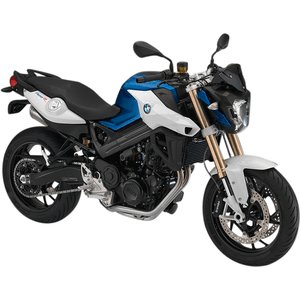BMW F 800 R (2015–2016): A Dynamic Roadster Built for Everyday Thrills
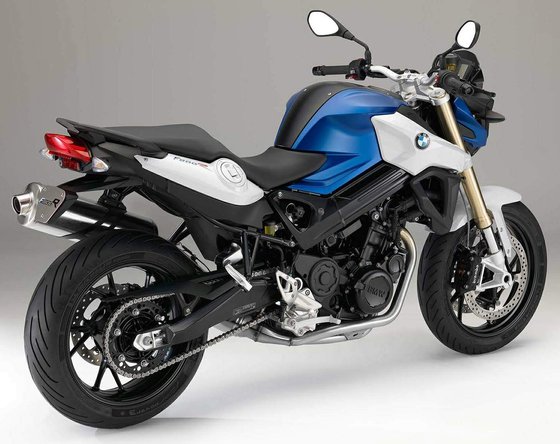
Introduction
The BMW F 800 R is the kind of motorcycle that makes you question why anyone would settle for ordinary. Designed as a naked roadster, it bridges the gap between practicality and adrenaline—a bike that’s equally at home carving through mountain passes, commuting in urban chaos, or even serving as a blank canvas for customization. Having spent time with this 2015–2016 generation, I can confidently say it’s a machine that rewards both seasoned riders and those transitioning from smaller bikes. Let’s dive into what makes this parallel-twin standout.
Engine and Performance: Precision Meets Punch
At the heart of the F 800 R lies a liquid-cooled 798cc parallel-twin engine, producing 90 hp (66 kW) at 8,000 rpm and 86 Nm (63 lb-ft) of torque at 5,800 rpm. BMW’s engineers struck a near-perfect balance here: the engine delivers linear power without the abruptness of a supersport, yet it’s eager enough to snap forward when you crack the throttle.
Riding Impressions:
- Low-to-Mid Range Dominance: The torque curve is flat and friendly, pulling strongly from 3,000 rpm. This makes overtaking effortless—no need to downshift aggressively.
- High-RPM Refinement: While it doesn’t scream like an inline-four, the twin hums smoothly up to its 8,500 rpm redline. The Akrapovič slip-on exhaust (a popular aftermarket upgrade) adds a throatier soundtrack.
- Fuel Efficiency: Averaging 4.2 L/100 km (56 mpg), this isn’t a gas-guzzler. The 15-liter tank offers a realistic 320–350 km (200–220 mi) range.
The 6-speed gearbox shifts crisply, though the clutch lever feels slightly heavy in stop-and-go traffic—a common trait of cable-operated systems. For newer riders, BMW’s optional 48 hp restrictor kit is a thoughtful touch.
Handling and Ergonomics: Agile, But Not Exhausting
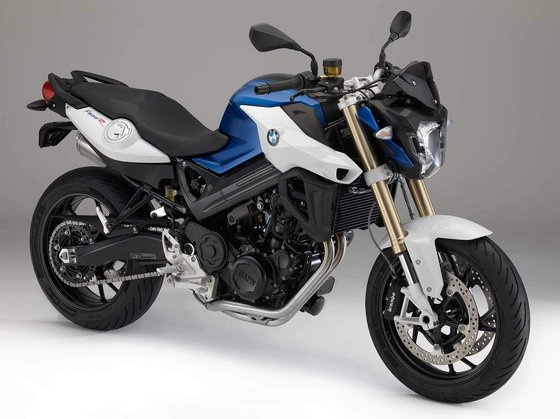
Weighing 202 kg (445 lbs) wet, the F 800 R isn’t the lightest in its class, but the aluminum bridge frame and 43 mm USD fork (upgraded from telescopic forks in earlier models) give it a planted yet nimble feel.
Key Takeaways:
- Steering Geometry: With a 25° rake and 91 mm trail, the bike turns in quickly without feeling twitchy. It’s forgiving mid-corner, too—ideal for riders still building confidence.
- Suspension Setup: The 125 mm (4.9 in) travel front and rear handles bumps competently, though aggressive riders might crave adjustable damping. Enter BMW’s optional ESA (Electronic Suspension Adjustment), a rarity in this segment.
- Ergonomics: The 790 mm (31.1 in) seat height accommodates shorter riders, while the tapered handlebars and repositioned footpegs (10 mm lower/forward) create a relaxed upright posture. After two hours in the saddle, my back thanked me.
Technology and Safety: Smarter Than It Looks
BMW’s “Safety 360°” ethos shines here. Standard ABS and optional ASC (traction control) add layers of security without dulling the experience.
Notable Features:
- Radial Brakes: Dual 320 mm front discs with 4-piston calipers deliver strong, progressive stopping power. The initial bite is less aggressive than Japanese rivals—perfect for rain mode panic stops.
- Instrument Cluster: The analog tachometer and digital display are minimalist but legible. Missing gear indicators? Aftermarket options abound.
- Lighting: The symmetrical LED headlights (a design standout) illuminate corners adequately, though auxiliary lights are wise for night touring.
Competition: How Does It Stack Up?
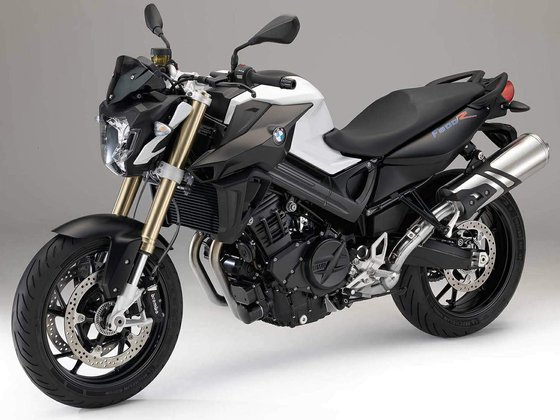
The F 800 R faces fierce rivals. Here’s how it holds its ground:
| Model | Pros | Cons |
|---------------------|-----------------------------------------------|--------------------------------------------|
| Yamaha MT-09 | More power (115 hp), lighter weight | Twitchy throttle, softer suspension |
| Triumph Street Triple 675 | Sharper handling, premium components | Higher seat height, pricier maintenance |
| Ducati Monster 821 | Italian flair, torquier engine | Heat management issues, shorter service intervals |
BMW’s Edge: The F 800 R isn’t the fastest or flashiest, but its blend of stability, ergonomics, and BMW’s safety tech makes it a Swiss Army knife for real-world riding. Plus, the chain drive (vs. Ducati’s belt) simplifies DIY maintenance.
Maintenance: Keeping the Twin Purring
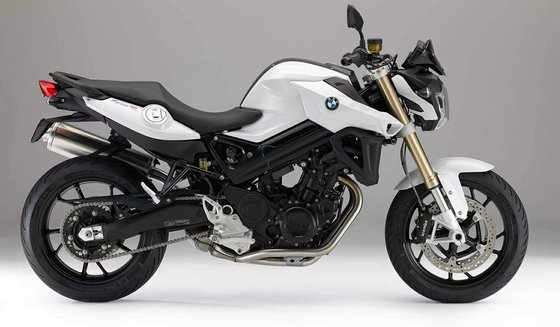
Owning an F 800 R isn’t just about riding—it’s about smart upkeep. Here’s what to prioritize:
Critical Service Items:
- Valve Adjustments: Every 20,000 km (12,400 mi). Clearances are 0.18–0.26 mm (intake) and 0.27–0.35 mm (exhaust). Use feeler gauges and patience.
- Oil Changes: 3.0L of 15W-50 (API SJ) every 10,000 km (6,200 mi). Don’t skip the filter—MOTOPARTS.store stocks OEM-spec replacements.
- Chain Care: The 120-link O-ring chain needs regular lubrication. Adjust tension to 25–35 mm (1–1.4 in). A worn 20/47 sprocket set? Swap it before it strands you.
- Brake Fluid: Flush DOT 4 every two years. Spongy levers are a warning sign.
- Tire Pressures: 2.5 bar (36 psi) front / 2.9 bar (42 psi) rear. Underinflation kills handling.
Pro Tips:
- Spark Plugs: NGK DCPR8E with a 0.8–0.9 mm gap ensures smooth cold starts.
- Coolant: Use silicate-free formula to prevent aluminum corrosion.
- Winter Storage: A battery tender is non-negotiable for the 14 Ah battery.
Conclusion: The Roadster That Does (Almost) Everything
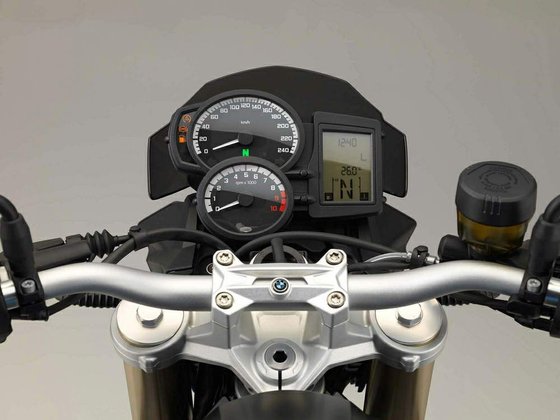
The BMW F 800 R isn’t about chasing lap times or Instagram fame. It’s about versatility—a bike that morphs from commuter to canyon carver with a twist of the wrist. The 2015–2016 updates (USD forks, radial brakes, sharper styling) addressed earlier criticisms, cementing its status as a benchmark in the middleweight naked segment.
For MOTOPARTS.store Shoppers: Whether you’re upgrading to an Akrapovič exhaust, swapping in lower handlebars, or just stocking up on maintenance kits, this BMW rewards those who invest in its care. It’s a canvas waiting for your personal touch—reliable enough for daily duty, spirited enough to remind you why you started riding in the first place.

Specifications sheet
| Engine | |
|---|---|
| Stroke: | Four-stroke |
| Max power: | 66 kW | 89.0 hp |
| Max torque: | 86 Nm |
| Fuel system: | Electronic fuel injection (BMS-KP) |
| Lubrication: | Wet sump |
| Max power @: | 8000 rpm |
| Displacement: | 798 ccm |
| Max torque @: | 5800 rpm |
| Bore x Stroke: | 82.0 x 75.6 mm (3.2 x 3.0 in) |
| Configuration: | Inline |
| Cooling system: | Liquid-cooled |
| Compression ratio: | 12.0:1 |
| Number of cylinders: | 2 |
| Features | |
|---|---|
| ABS: | Standard |
| Frame materials: | Load-bearing engine design |
| Optional systems: | ['ASC (traction control)', 'ESA (electronic suspension adjustment)', '35 kW power restrictor'] |
| Emission standard: | EU-3 compliant |
| Dimensions | |
|---|---|
| Wheelbase: | 1520 mm (59.8 in) |
| Dry weight: | 177 |
| Wet weight: | 202 |
| Seat height: | 790 mm (31.1 in) adjustable via optional seats |
| Overall width: | 905 mm (35.6 in) |
| Overall height: | 1160 mm (45.7 in) |
| Overall length: | 2145 mm (84.4 in) |
| Ground clearance: | 165 mm (6.5 in) |
| Fuel tank capacity: | 15.0 L (4.0 US gal) |
| Drivetrain | |
|---|---|
| Final drive: | chain |
| Gear ratios: | 1st 2.462, 2nd 1.750, 3rd 1.381, 4th 1.227, 5th 1.130, 6th 1.042 |
| Chain length: | 120 |
| Transmission: | 6-speed |
| Rear sprocket: | 47 |
| Front sprocket: | 20 |
| Electrical | |
|---|---|
| Battery: | 12V 14Ah maintenance-free |
| Headlight: | Symmetrical dual-headlight design |
| Alternator: | 400W three-phase |
| Maintenance | |
|---|---|
| Rear tire: | 180/55 z-17 |
| Engine oil: | 15W50 |
| Front tire: | 120/70 z-17 |
| Idle speed: | 1250 ± 50 rpm |
| Brake fluid: | DOT 4 |
| Spark plugs: | NGK DCPR8E |
| Spark plug gap: | 0.8-0.9 mm |
| Coolant capacity: | 1.7 |
| Engine oil capacity: | 3.0 |
| Engine oil change interval: | Every 5000 km or 2 years |
| Valve clearance (intake, cold): | 0.18–0.26 mm |
| Valve clearance check interval: | 24,000 km (15,000 mi) |
| Valve clearance (exhaust, cold): | 0.27–0.35 mm |
| Recommended tire pressure (rear): | 2.9 bar (42 psi) |
| Recommended tire pressure (front): | 2.5 bar (36 psi) |
| Chassis and Suspension | |
|---|---|
| Frame: | Aluminum twin-spar bridge frame |
| Rear wheel: | 5.50 x 17" cast aluminum |
| Front wheel: | 3.50 x 17" cast aluminum |
| Rear brakes: | Single 265 mm disc, 1-piston caliper (ABS standard) |
| Front brakes: | Dual 320 mm discs, 4-piston radial calipers (ABS standard) |
| Rear suspension: | Cast aluminum swingarm with monoshock, adjustable preload and rebound damping, 125 mm travel |
| Front suspension: | 43mm USD fork (2016) / Telescopic fork (2015), 125 mm travel |



